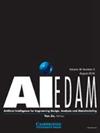A comparative review on the role of stimuli in idea generation
IF 2.3
3区 工程技术
Q3 COMPUTER SCIENCE, ARTIFICIAL INTELLIGENCE
Ai Edam-Artificial Intelligence for Engineering Design Analysis and Manufacturing
Pub Date : 2023-06-23
DOI:10.1017/S0890060423000124
引用次数: 1
Abstract
Abstract This paper reports a systematic literature review with the aim of determining the role of stimuli and other factors, such as timing, the designers’ background, expertise, and experience, in the idea generation phase of conceptual design related to engineering and industrial design and architecture. “Stimulus” is a general expression for a source of information characterized by several features, including the source (internal or external), analogical distance (near or far), and form (textual, visual, or other). Several recent studies have been conducted on this topic involving neurophysiological measurements with significant results. This comprehensive review will help to determine if the neurophysiological results are consistent with those from protocol studies. This allows for determining how the features of stimuli affect – among the related factors – designers’ performance in idea generation. The literature search was carried out using the Snowball and PRISMA methods. A total of 72 contributions were selected from studies adopting protocol analysis or neurophysiological measurements. This study presents a framework to support the selection of stimuli most likely to maximize performance, based on the designer's background and expertise in the different idea generation metrics. The main findings of the framework suggest that visual stimuli enhance the creative performance of designers, regardless of their background, while textual stimuli foster the variety and quality of ideas, but only in engineering and industrial designers. Comparing the findings, the resulting framework reveals aspects of stimuli that require further investigation. These can be considered valuable insights for new directions for design research.刺激在创意产生中的作用的比较综述
摘要本文报告了一篇系统的文献综述,旨在确定刺激和其他因素,如时间、设计师的背景、专业知识和经验,在与工程、工业设计和建筑相关的概念设计的想法生成阶段的作用。“刺激”是对信息来源的一般表达,其特征有几个,包括来源(内部或外部)、类比距离(近或远)和形式(文本、视觉或其他)。最近对这个主题进行了几项研究,涉及神经生理学测量,并取得了显著的结果。这项全面的综述将有助于确定神经生理学结果是否与方案研究的结果一致。这允许确定刺激的特征如何影响——在相关因素中——设计师在创意产生中的表现。文献检索采用雪球法和PRISMA法。从采用方案分析或神经生理学测量的研究中总共选择了72项贡献。这项研究提供了一个框架,以支持根据设计师在不同想法生成指标方面的背景和专业知识,选择最有可能实现性能最大化的刺激因素。该框架的主要发现表明,视觉刺激可以增强设计师的创造性表现,无论他们的背景如何,而文本刺激可以促进想法的多样性和质量,但仅限于工程和工业设计师。通过对研究结果的比较,得出的框架揭示了需要进一步研究的刺激因素。这些可以被认为是设计研究新方向的宝贵见解。
本文章由计算机程序翻译,如有差异,请以英文原文为准。
求助全文
约1分钟内获得全文
求助全文
来源期刊
CiteScore
4.40
自引率
14.30%
发文量
27
审稿时长
>12 weeks
期刊介绍:
The journal publishes original articles about significant AI theory and applications based on the most up-to-date research in all branches and phases of engineering. Suitable topics include: analysis and evaluation; selection; configuration and design; manufacturing and assembly; and concurrent engineering. Specifically, the journal is interested in the use of AI in planning, design, analysis, simulation, qualitative reasoning, spatial reasoning and graphics, manufacturing, assembly, process planning, scheduling, numerical analysis, optimization, distributed systems, multi-agent applications, cooperation, cognitive modeling, learning and creativity. AI EDAM is also interested in original, major applications of state-of-the-art knowledge-based techniques to important engineering problems.

 求助内容:
求助内容: 应助结果提醒方式:
应助结果提醒方式:


